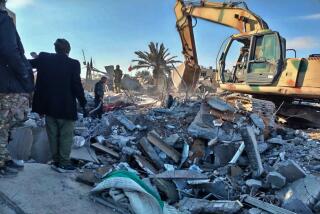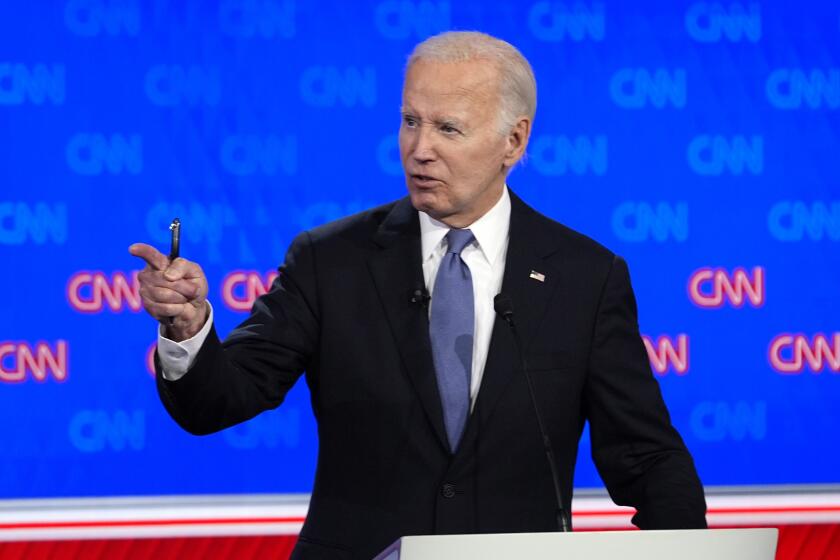With more than 1,000 sanctions on Iran, Trump adds a few more

Treasury Secretary Steve Mnuchin and Secretary of State Mike Pompeo made the announcement Friday from the White House briefing room.
The Trump administration announced new sanctions Friday against Iran, a largely symbolic turn of the screws on a country already facing more than 1,000 U.S. sanctions that have devastated its economy but have not forced Tehran to negotiate with Washington or end support for militant groups across the Middle East.
The move marks the administration’s first concrete response to Iran’s missile strikes early Wednesday on two Iraqi bases that house U.S. troops, and it underlined the limited options available to the White House — short of direct military action — as it seeks to pressure Iran to bend to its will.
Although President Trump and the mullahs in Tehran both pulled back from the brink of war, the latest U.S.-Iran crisis continued to send aftershocks around the globe — and worries about what comes next.
The Islamic State celebrated the U.S. drone strike that killed Iran’s most powerful general, Qassem Suleimani, in Baghdad on Jan. 3. In its aftermath, the U.S. temporarily suspended military operations in Iraq and Syria aimed at eliminating remnants of the once-feared group, raising fears of a resurgence.
Washington and Tehran “don’t care about ... the common fight against Islamic State,” the militant group said in a taunting bulletin. It added that its fighters had spent years trying to assassinate Suleimani only for his death to come “at the hands” of their enemies.
While Suleimani had directed deadly attacks on U.S. personnel and targets during the American occupation of Iraq, Iranian troops and proxy militias also played a key role in the five-year ground war that pushed Islamic State out of its strongholds in Iraq and Syria, ending its self-described caliphate but not the terrorist threat.
“We need to understand that the fight against [Islamic State] is not over,” NATO Secretary-General Jens Stoltenberg told reporters after an emergency meeting Friday of the European Union in Brussels. EU foreign ministers also expressed concern of an Islamic State revival.
In Baghdad, Iraq’s caretaker prime minister, Adel Abdul Mahdi, asked Secretary of State Michael R. Pompeo in a phone call to send a delegation to “put in place the mechanisms” for “a safe withdrawal” of U.S. troops as a reaction to the U.S. targeted killing of the Iranian general on Iraqi soil, according to the Iraqi leader’s office.
Although Trump has said he wants to reduce the U.S. presence in the region, his administration rejected the Iraqi request. About 5,200 U.S. personnel are posted in Iraq to train security forces and help with military operations against Islamic State remnants.
“Any delegation sent to Iraq would be dedicated to discussing how to best recommit to our strategic partnership — not to discuss troop withdrawal,” Morgan Ortagus, a State Department spokeswoman, said Friday.
Last week, a Marine general in Iraq sent a letter advising the Iraqi military that the Pentagon was relocating some troops and making plans for withdrawal. The Pentagon later said that the letter was sent in error and denied a pullout was underway, leading to widespread confusion.
It’s unclear what options, if any, Iraq has. On Sunday, after Iraqi lawmakers passed a nonbinding resolution calling on foreign troops to leave, Trump responded by threatening to slap stiff sanctions on the U.S. ally.
“Baghdad is trying to surgically remove a tumor and save the patient,” said Ramzy Mardini, a political scientist at the University of Chicago. But U.S. officials are signaling “that it’s not going to work like that.”
In Washington, the Trump administration said it would temporarily ease travel bans and other restrictions that might impede international assistance to investigate the crash of a Ukraine International Airlines passenger jet Wednesday morning as it took off from Tehran, killing all 176 aboard, shortly after Iran had fired more than a dozen missiles at U.S. forces at bases in Iraq.
U.S. intelligence agencies assessed that an Iranian antiaircraft missile likely hit the Boeing 737, which was bound for Kyiv, possibly as an accident. Iran has denied firing missiles at the plane.
“We do believe that it’s likely that the plane was shot down by an Iranian missile,” Pompeo told reporters Friday at the White House. “We’re going to let the investigation play out before we make a final determination. It’s important that we get to the bottom of it.”
The latest U.S. sanctions target Iran’s construction, manufacturing and mining industries, including its largest steel and iron producers, and eight officials, a relatively modest addition to the vast array of U.S. sanctions the Trump administration has imposed under a policy it calls “maximum pressure.”
Pompeo announced the penalties with Treasury Secretary Steven T. Mnuchin. saying the goal is to “deny the regime the resources to conduct its destructive foreign policy.”
The sanctions, they said, would remain in place until Iran ended its support of regional militant groups and what it claims is Tehran’s pursuit of nuclear weapons.
Mnuchin insisted that “economic sanctions are working.” Without them, he said, Iran would have “tens of billions of dollars” that it could use “for terrorist activities.”
Trump told reporters Thursday that sanctions already “were very severe, but now it’s increased substantially.”
Richard Nephew, who served as State Department sanctions coordinator in the Obama administration, said sanctions can be a valuable diplomatic tool in limited scenarios or as part of a broader strategy. But he said the Trump administration is making huge demands that Iran is unlikely to meet.
“Do sanctions work if you’re basically asking for the moon? Probably not,” he said.
Nephew said the Treasury Department is slapping sanctions on some Iranians for the second time or more.
Trump’s aides know “that the practical effect of what’s being done here isn’t much. But it allows them to say that they’ve done something,” he said.
Iran has survived U.S. and international military and economic sanctions since the Islamic Revolution in 1979 overthrew the U.S.-backed government in Tehran.
But Trump has steadily ramped up pressure on Iran’s energy, financial and other key sectors — and helped send the Iranian economy into a tailspin — since mid-2018, when he withdrew from the international accord designed to cut off Iran’s potential pathway to a nuclear bomb. Iran has always denied it was seeking nuclear weapons.
According to the State Department, the Trump administration slapped about 700 Iranian companies, entities and individuals with sanctions by the end of 2018, and has added more than 300 since then.
In an address Wednesday, Trump urged the five other world powers that signed the 2015 nuclear agreement — the United Kingdom, France, Germany, Russia and China — to also withdraw, but none have signaled any intent to do so.
He has urged Iran to renegotiate the deal, but Iran’s leaders have dismissed his offer and the two sides remain at an impasse.
In some ways, the latest sanctions represent a return to the uneasy status quo of recent years. But the region remains tense, with Iran’s leaders vowing additional retaliation and U.S. forces and diplomats on alert for further reprisals.
“Clearly, Trump, and for that matter the Iranians, seek to avoid all-out war,” said Michael Doran, a senior fellow at the Hudson Institute, a conservative think tank in Washington. But he said Trump had “changed the nature of the game” by killing Suleimani.
“Instead of going after its proxies, as the Americans have traditionally done, Trump killed the man who built and controlled the proxies,” he said. “Having taken such a move once, Tehran knows he can do it again.”
Although Iran has named a successor to Suleimani, it’s unclear if Brig. Gen. Esmail Qaani can exert the same degree of influence on the dozens of Iran-backed militias in Iraq, Syria, Yemen and Lebanon.
Pompeo defended the administration’s initial claims that intelligence showed Suleimani was plotting an “imminent” attack on U.S. forces or facilities as legal justification for killing a senior government official outside a war zone.
In a Fox News interview Thursday, Pompeo admitted that the intelligence didn’t say “when or where” an attack would take place. On Friday, he argued that the two statements were “completely consistent thoughts.”
“It was very clear … those attacks were imminent,” he said after being pressed by reporters. “This was going to happen and American lives were at risk. And we would be culpably negligent if we did not recommend to the president he take this action against Suleimani.”
Stokols and Megerian reported from Washington and Bulos from Baghdad. Times staff writers Noah Bierman and Tracy Wilkinson in Washington contributed to this report.
More to Read
Get the L.A. Times Politics newsletter
Deeply reported insights into legislation, politics and policy from Sacramento, Washington and beyond. In your inbox three times per week.
You may occasionally receive promotional content from the Los Angeles Times.









